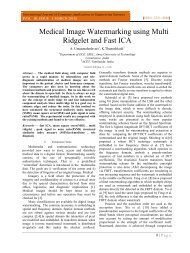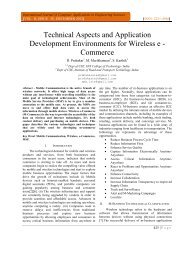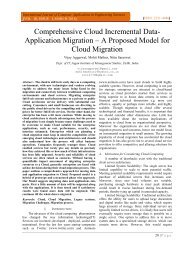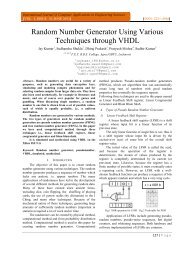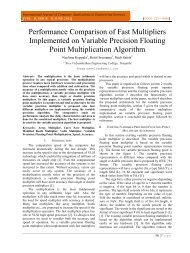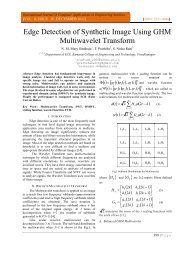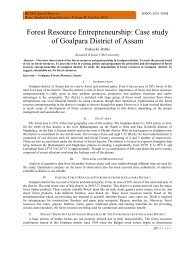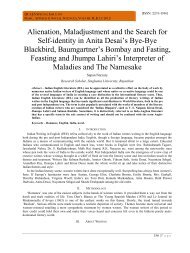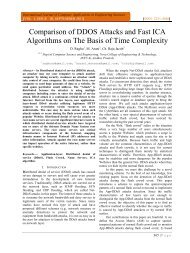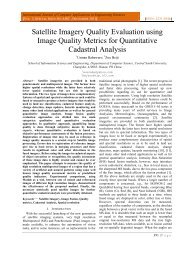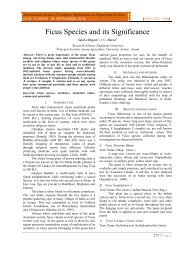Multilayer Perceptron Network in HIV/AIDS Application
Multilayer Perceptron Network in HIV/AIDS Application
Multilayer Perceptron Network in HIV/AIDS Application
Create successful ePaper yourself
Turn your PDF publications into a flip-book with our unique Google optimized e-Paper software.
International Journal of Computer <strong>Application</strong>s <strong>in</strong> Eng<strong>in</strong>eer<strong>in</strong>g Sciences (IJCAES) [VOL I, ISSUE I, MARCH 2011]<strong>Multilayer</strong> <strong>Perceptron</strong> <strong>Network</strong> <strong>in</strong> <strong>HIV</strong>/<strong>AIDS</strong><strong>Application</strong>Manasw<strong>in</strong>i Pradhan 1 , Ranjit Kumar Sahu 21 P.G. Department of Information and Communication Technology,Fakir Mohan University, Orissa, India2 Consultant, Plastic ,Cosmetic and Laser Surgery, Mumbai, India1 ms.manasw<strong>in</strong>i.pradhan@gmail.com,2 drsahurk@yahoo.co.<strong>in</strong>Abstract--The paper discusses a new method of MultiLayered <strong>Perceptron</strong> (MLP) network to classify <strong>HIV</strong>/<strong>AIDS</strong><strong>in</strong>fected and non-<strong>in</strong>fected status of <strong>in</strong>dividuals. For thispurpose, seven features on the basis of patient’s unique likeage, sex, weight, HB, CD4, CD8 and TB were used as <strong>in</strong>putdata. In order to determ<strong>in</strong>e the applicability and bestperformance of the MLP network, three different tra<strong>in</strong><strong>in</strong>galgorithms like Back Propagation, Levenberg-Marquardt,and Bayesian Rule algorithms, were employed to tra<strong>in</strong> theMLP networks. The f<strong>in</strong>d<strong>in</strong>gs conclude that the MLPnetwork tra<strong>in</strong>ed us<strong>in</strong>g Back Propagation algorithmproduced the best performance with 89.80% accuracy ascompared to Levenberg-Marquardt and Bayesian Rulealgorithms. The results also significantly demonstrated thesuitability of the MLP network for calculat<strong>in</strong>g andspecify<strong>in</strong>g the <strong>HIV</strong>/AIDs positive/negative status of thepatient.Keywords--Multi Layered <strong>Perceptron</strong> (MLP), Backpropagation, Levenberg-Marquardt, Bayesian, Regimens,<strong>HIV</strong>/AIDs.I. INTRODUCTIONAcquired Immunodeficiency Syndrome (<strong>AIDS</strong>) wasfirst def<strong>in</strong>ed <strong>in</strong> 1982 to describe the cases of unusualimmune system failure due to an unknown andunidentified <strong>in</strong>fection <strong>in</strong> the previous years. The HumanImmunodeficiency Virus (<strong>HIV</strong>) was later identified asthe cause of <strong>AIDS</strong>. In a large number of medicalapplications, classification is desired to differentiate apattern of low frequency from a pattern of highfrequency. Cl<strong>in</strong>ical trail system for <strong>HIV</strong>/AIDs is acomplex one. It is an <strong>in</strong>curable disease. More thanmillions of people are <strong>HIV</strong> positive. Recent researchshows that computational <strong>in</strong>telligence has been widelyused on medical diagnosis to solve complex problemsby develop<strong>in</strong>g decision support system with theapplication of Neural <strong>Network</strong> algorithms. Neural<strong>Network</strong> is an appropirate application to practice mostof the medical problems. It has many algorithms forclassification, prediction, image process<strong>in</strong>g, etc. Aproper utilization of a Neural <strong>Network</strong> technique toimplement a large-scale health services research datasetis one of the most difficult areas <strong>in</strong> the Neural <strong>Network</strong>field. Due to <strong>in</strong>correctly def<strong>in</strong>ed and unstructuredfactors, it becomes further complicated affect<strong>in</strong>g thefunctional health status of <strong>HIV</strong>/<strong>AIDS</strong> patients. Many ofthe studies have applied Neural <strong>Network</strong> technique toclassify and predict desired solution or to improvemethodological aspects.<strong>Multilayer</strong>ed perceptron(MLP) network tra<strong>in</strong>ed us<strong>in</strong>gback propagation(BP) algorithm is one of the mostpopular choice <strong>in</strong> neural network applications. Thepresent study proposes the MLP network to classify the<strong>HIV</strong> positive/negative <strong>in</strong>dividuals and compare theperformance of various available tra<strong>in</strong><strong>in</strong>g algorithmsnamely back propagation, Levenberg-Marquardt andBayesian rule.II. REVIEW OF RELATED RESEARCHThe Human Immunodeficiency Virus (<strong>HIV</strong>) is one ofthe ma<strong>in</strong> causes of human death <strong>in</strong> the world. The <strong>HIV</strong>is a human pathogen that <strong>in</strong>fects certa<strong>in</strong> types oflymphocytes called T-helper cells, which are importantto the immune system. Without a sufficient number ofT-helper cells, the immune system is unable to defendthe body aga<strong>in</strong>st <strong>in</strong>fections, thereby mak<strong>in</strong>g it vulnerableto various <strong>in</strong>fections and diseases and f<strong>in</strong>ally itsuccumbs.Acquired immunodeficiency syndrome (<strong>AIDS</strong>) wasfirst def<strong>in</strong>ed [1] <strong>in</strong> 1982 to describe the first cases ofunusual immune system failure that were identified <strong>in</strong>the previous year.The human immunodeficiency virus ( <strong>HIV</strong>) was lateridentified as the cause of <strong>AIDS</strong>.As an <strong>in</strong>dicator, the riskfactor epidemiology exam<strong>in</strong>es the <strong>in</strong>dividualdemographic and social characteristics and attempts todeterm<strong>in</strong>e factors that place an <strong>in</strong>dividual at risk ofacquir<strong>in</strong>g a life-threaten<strong>in</strong>g disease [2]. Thedemographic and social characteristics of the <strong>in</strong>dividualsand their behavior are used to determ<strong>in</strong>e the risk of <strong>HIV</strong><strong>in</strong>fection; referred to as biomedical <strong>in</strong>dividualism [2],[3]. By identify<strong>in</strong>g the <strong>in</strong>dividual risk factors that lead toPage | 41
International Journal of Computer <strong>Application</strong>s <strong>in</strong> Eng<strong>in</strong>eer<strong>in</strong>g Sciences (IJCAES) [VOL I, ISSUE I, MARCH 2011]the <strong>HIV</strong> <strong>in</strong>fection, it is possible to modify socialconditions, which give rise to the disease, and thusdesign effective <strong>HIV</strong> prevention policies. A model willbe created and used to classify the <strong>HIV</strong> status of<strong>in</strong>dividuals based on demographic properties. In thisstudy, the model is created us<strong>in</strong>g autoencoder neuralnetworks and genetic algorithms, which have beenapplied for classification.An artificial neural network (ANN) is an <strong>in</strong>terconnectedstructure of process<strong>in</strong>g elements. The ANNstructure [4] used for this study consists of three ma<strong>in</strong>components (Fig. 1) [5]. These are the <strong>in</strong>put layer, thehidden layer and the output layer.Neural networks have been successfully used formedical <strong>in</strong>formatics, for decision mak<strong>in</strong>g, cl<strong>in</strong>icaldiagnosis, prognosis, and prediction of outcomes [6]-[10] and also for classification. Marwala [11] used aprobabilistic committee of neural networks to classifyfaults <strong>in</strong> a population of nom<strong>in</strong>ally identical cyl<strong>in</strong>dricalshells and obta<strong>in</strong>ed an accuracy of 95%, <strong>in</strong> classify<strong>in</strong>geight classes of fault cases. Ohno-Machado [12]depicted the limitation on the accuracy of the neuralnetwork model due to lack of data balance and <strong>in</strong>creasedthe accuracy by us<strong>in</strong>g sequential neural networks.Lisboa [13] assessed the evidence of healthcare benefitsus<strong>in</strong>g neural networks. Fernandez and Caballero [14]used ANN to model the activity of cyclic urea <strong>HIV</strong>-1protease <strong>in</strong>hibitors. They showed that ANN was capableof represent<strong>in</strong>g the nonl<strong>in</strong>earity <strong>in</strong> the <strong>HIV</strong> model. Leeand Park [15] applied neural networks to classify andpredict the symptomatic status of <strong>HIV</strong>/<strong>AIDS</strong> patientsbased on publicly available <strong>HIV</strong>/<strong>AIDS</strong> data. A studywas also performed to predict the functional healthstatus of <strong>HIV</strong>/<strong>AIDS</strong> patients def<strong>in</strong>ed as „<strong>in</strong> good health‟or „not <strong>in</strong> good health‟, us<strong>in</strong>g neural networks [16].Laumann and Youm [17] used the racial and ethnicgroup differences to model the prevalence of thedisease and succeeded <strong>in</strong> relat<strong>in</strong>g the demographicproperties to the transmission of the disease.Poundstone and others [2] related demographicproperties to the spread of <strong>HIV</strong>. Their work justified theuse of such demographic properties <strong>in</strong> creat<strong>in</strong>g a modelto predict the <strong>HIV</strong> status of <strong>in</strong>dividuals, as done <strong>in</strong> thepresent paper.All the models refereed above concluded that ANNperforms better <strong>in</strong> <strong>HIV</strong> classification problems. Themethodology adopted here aims at us<strong>in</strong>g demographicand social factors, to predict the <strong>HIV</strong> status of an<strong>in</strong>dividual, us<strong>in</strong>g autoencoder neural networks. Themost common neural network architecture is themultilayer perceptron (MLP). An alternative network isthe Radial Basis Function (RBF) [5]. The use of MLPover RBF can be attributed to the fact that the RBFusually requires the implementation of the pseudo<strong>in</strong>verseof a matrix for tra<strong>in</strong><strong>in</strong>g, which is often s<strong>in</strong>gularwhile MLP uses conventional feedforward optimizationmethods, which are stable[5]. In the present case,prelim<strong>in</strong>ary design showed that the MLP hasoutperformed. This can be attributed to the fact thatMLP networks, also known as universal approximators,are capable of model<strong>in</strong>g any complex relationship withone or two hidden layers and are thus most suited forthis study. For a detailed analysis on neural networksand MLP one can refer to the studies made by [18]-[22]For the purpose of the present paper, neural networksare used with genetic algorithms. A genetic algorithm(GA) is an optimization method deriv<strong>in</strong>g its behaviorfrom processes of evolution <strong>in</strong> nature, <strong>in</strong>spired byDarw<strong>in</strong>‟s theory of natural evolution [23],[24]. This isdone by the creation of a population tak<strong>in</strong>g <strong>in</strong>dividualswith<strong>in</strong> a mach<strong>in</strong>e/computer. In this study, the populationof <strong>in</strong>dividuals represents the miss<strong>in</strong>g <strong>in</strong>put entries. The<strong>in</strong>dividuals then go through the process of evolution.GA uses fitness-proportionate or tournament selection toselect the miss<strong>in</strong>g entries (<strong>in</strong>dividuals), probabilisticallythat yields the right <strong>HIV</strong> status for the <strong>in</strong>dividuals.Although not guaranteed to provide the globallyoptimum solution, GA has been shown to be highlyefficient at reach<strong>in</strong>g to a very near optimum solution <strong>in</strong> acomputationally efficient manner [23],[24]. For moredetails on GA one can refer to Davis and Michalewicz[25],[26]. In the literature review, there is no methodproposed thus far that <strong>in</strong>vestigates the use ofAutoencoder networks for <strong>HIV</strong> model<strong>in</strong>g which is basedon autoassociative models [27] comb<strong>in</strong>ed with GA toclassify the <strong>HIV</strong> status of an <strong>in</strong>dividual based ondemographic properties.<strong>Multilayer</strong>ed perceptron (MLP) network tra<strong>in</strong>edus<strong>in</strong>g back propagation (BP) algorithm is the mostpopular choice <strong>in</strong> neural network applications. Thepresent study proposes the MLP network to predict<strong>HIV</strong>/<strong>AIDS</strong> Regimen specification and compare theperformance of various available tra<strong>in</strong><strong>in</strong>g algorithmsnamely back propagation, Levenberg-Marquardt andBayesian rule.This paper is sequenced as follows. Section 3discusses the basic concept of the MLP network.Section 4 outl<strong>in</strong>es the tra<strong>in</strong><strong>in</strong>g algorithms employed <strong>in</strong>this research. Section 5 discusses the methodology.Section 6 reflects the result and discussion. F<strong>in</strong>ally,section 7 outl<strong>in</strong>es the conclusion.III.MULTILAYERED PERCEPTRON NETWORKA MLP network is a feed forward neural networkwith one or more hidden layers. Cybenko and Funahashi[28], [29] have proved that the MLP network is ageneral function approximator and the MLP networkwith one hidden layer (as shown <strong>in</strong> Fig. 1) is sufficientto approximate any cont<strong>in</strong>uous function. Based on Fig.1, the <strong>in</strong>put layer acts as an <strong>in</strong>put data buffer thatPage | 42
International Journal of Computer <strong>Application</strong>s <strong>in</strong> Eng<strong>in</strong>eer<strong>in</strong>g Sciences (IJCAES) [VOL I, ISSUE I, MARCH 2011]distributes the <strong>in</strong>put to the hidden layer. The outputsfrom the hidden layer then become the <strong>in</strong>puts to theoutput layer, which provides the network output.A hidden neuron performs two functions, i.e. thecomb<strong>in</strong><strong>in</strong>g function and the activation function.Consider a MLP network with n i <strong>in</strong>put nodes, the outputof the j-th neuron of the hidden layer is given by:v j (t)=F((nii1w x ( t) b ); for1 j n1jiij1where the w ji denotes the weights that connect the <strong>in</strong>putand hidden layer; x i and b i denote the <strong>in</strong>put that aresupplied to the <strong>in</strong>put layer and thresholds <strong>in</strong> hiddennodes respectively; n i and n h are number of <strong>in</strong>putnodes and hidden nodes respectively.h(1)The output of the k-th output neuron, y k <strong>in</strong> the outputlayer is given by:n h 2w kjy k^t =j=1v j (t);for 1
International Journal of Computer <strong>Application</strong>s <strong>in</strong> Eng<strong>in</strong>eer<strong>in</strong>g Sciences (IJCAES) [VOL I, ISSUE I, MARCH 2011]the hidden layer which is back propagated <strong>in</strong> thenetwork. S<strong>in</strong>ce the activation function of the outputneuron is l<strong>in</strong>ear, the error signal at the output node is ( t) y ( t)y ^ ( t)(8)kkand for the neurons <strong>in</strong> the hidden layerk'2 ( t) F ( x ( t)) ( t)w ( t 1)(9)j'where ( x ( t))ijjF iis the first derivative of F( x ( t))with respect to x i(t).S<strong>in</strong>ce back propagation algorithm is a steepest decenttype algorithm, the algorithm suffers from a slowconvergence rate. The search for the global m<strong>in</strong>ima maybe trapped at local m<strong>in</strong>ima and the algorithm can besensitive to the user selectable parameters (Mashor, M.Y. 2003)B. Levenberg-Marquardt AlgorithmLevenberg-Marquardt algorithm is a gradient-based,determ<strong>in</strong>istic local optimization algorithm. TheLevenbergMarquardt algorithm has an advantage overthe traditional Back Propagation algorithm, where it canprovide faster (second-order) convergence rate and keeprelative stability. [32],[33].Like the quasi-Newton methods, the Levenberg-Marquardt algorithm was designed to approach secondordertra<strong>in</strong><strong>in</strong>g speed without hav<strong>in</strong>g to compute theHessian matrix. When the performance function has theform of a sum of squares (as is typical <strong>in</strong> tra<strong>in</strong><strong>in</strong>g feedforward networks), then the Hessian matrix can beapproximated as:TH J J(10)and the gradient can be computed as:Tg J e(11)where J is the Jacobian matrix that conta<strong>in</strong>s firstderivatives of the network errors with respect to theweights and biases, and e is a vector of network errors.The Jacobian matrix can be computed through astandard back propagation technique that is much lesscomplex than comput<strong>in</strong>g the Hessian matrix [34].TheLevenberg-Marquardt algorithm uses this approximationto the Hessian matrix <strong>in</strong> the follow<strong>in</strong>g Newton-likeupdate:T 1 TJJ µ I J e w (12)jiiwhereparameter. w is a differential weights and µ is a controlWhen the scalar µ is zero, it is similar to Newton‟smethod, us<strong>in</strong>g the approximate Hessian matrix. When µis large, it becomes gradient descent with a small stepsize. Newton's method is faster and more accurate nearan error m<strong>in</strong>imum, so the aim is to shift towardsNewton's method as quickly as possible. Thus, µ isdecreased after each successful step (reduction <strong>in</strong>performance function) and is <strong>in</strong>creased only when atentative step would <strong>in</strong>crease the performance function.In this way, the performance function will always bereduced at each iteration of the algorithm [34].C. Bayesian Rule AlgorithmGiven the Baye‟s Rule asP(D | )P( | D) (13)P(D)Where P() is the prior probability of a parameter before hav<strong>in</strong>g seen the data and p( | D)called thelikelihood were the probability of the data D.Bayes‟ Rule is used to determ<strong>in</strong>e the posteriorprobability of θ given the data D [34]. In general thiswill provide an entire distribution over possible valuesof θ. This process was applied to neural networks andcome up with the probability distribution over thenetwork weights, w, given the tra<strong>in</strong><strong>in</strong>g data. Whenf<strong>in</strong>d<strong>in</strong>g a posterior distribution over weights,p(D | w)p(w)p(w | D)p(D)p(D | w)= p(D | w)p(w)dw(14)In the Bayesian formalism, learn<strong>in</strong>g the weightsmeans chang<strong>in</strong>g our belief about the weights from theprior, p (w), to the posterior p ( w | D), as aconsequence of see<strong>in</strong>g the data as illustrated by Fig. 2.Fig. 2 Chang<strong>in</strong>g prior weights to posterior weightsPage | 44
International Journal of Computer <strong>Application</strong>s <strong>in</strong> Eng<strong>in</strong>eer<strong>in</strong>g Sciences (IJCAES) [VOL I, ISSUE I, MARCH 2011]V. METHODOLOGY AND DATA SAMPLESAs discussed earlier, the study focuses onclassification of <strong>HIV</strong>/<strong>AIDS</strong> <strong>in</strong>fected and non-<strong>in</strong>fected<strong>in</strong>dividuals. To determ<strong>in</strong>e the applicability of the MLPnetwork as <strong>HIV</strong>/<strong>AIDS</strong> diagnosis technique, the MLPnetwork needs to go through tra<strong>in</strong><strong>in</strong>g and test<strong>in</strong>g phases.Dur<strong>in</strong>g both phases, the optimum structure anddiagnosis performance of the MLP networks aredeterm<strong>in</strong>ed. The performance analysis of the MLPnetwork is based on accuracy. Accuracy is def<strong>in</strong>ed asthe percentage of overall correct determ<strong>in</strong>ation of<strong>HIV</strong>/<strong>AIDS</strong> cases. The data are taken from National<strong>AIDS</strong> Control Organization (NACO), India. Sevenunique factors like age, sex, weight, HB, CD4, CD8 andTB used as <strong>in</strong>put data to the MLP network. 200 Patient‟smedical <strong>in</strong>formation was used as tra<strong>in</strong><strong>in</strong>g data while therema<strong>in</strong><strong>in</strong>g 100 data were used as test<strong>in</strong>g data. The dataare fed randomly <strong>in</strong>to the MLP network. It wasimplemented us<strong>in</strong>g MATLAB 7.10 neural network tool(nntool). An <strong>in</strong>put layer is used to represent set of <strong>in</strong>putvariables (seven <strong>in</strong>put variables). Input pattern has theseven variables: age, sex, weight, CD4 count, CD8count, HB rate and TB are taken as network parameter.VI.RESULT AND DISCUSSIONBy perform<strong>in</strong>g the relevant tra<strong>in</strong><strong>in</strong>g, the optimumnumbers of hidden nodes and tra<strong>in</strong><strong>in</strong>g epochs wereobta<strong>in</strong>ed. This was obta<strong>in</strong>ed when the MLP networkachieves the highest performance. Fig. 3 (a) and (b)show the result of obta<strong>in</strong><strong>in</strong>g the optimum tra<strong>in</strong><strong>in</strong>gepochs and number of hidden node for back propagationalgorithm respectively. The MLP network us<strong>in</strong>g backpropagation algorithm achieves the highest performanceat the number of hidden nodes equal to 2200 and 14 fortra<strong>in</strong><strong>in</strong>g epochs. This records the optimum level and isalso the highest us<strong>in</strong>g the parameters referred earlier.X: 14 ; Y: 0.898(b)Hidden NodeFig. 3 Performance of the MLP network with Back propagationalgorithmResults for Levenberg-Marquardt tra<strong>in</strong><strong>in</strong>g algorithmare shown <strong>in</strong> Fig. 4.This tra<strong>in</strong><strong>in</strong>g algorithm produced thebest performance at 100 tra<strong>in</strong><strong>in</strong>g epochs and 7 hiddennodesX: 100 ; Y: 0.8735X: 2200 ; Y:0.8694(a)Tra<strong>in</strong><strong>in</strong>g EpochesX: 7 ; Y: 0.8735(a)Tra<strong>in</strong><strong>in</strong>g EpochsPage | 45
International Journal of Computer <strong>Application</strong>s <strong>in</strong> Eng<strong>in</strong>eer<strong>in</strong>g Sciences (IJCAES) [VOL I, ISSUE I, MARCH 2011](b)Hidden NodeFig. 4 Performance of the MLP network with Levenberg-Marquardtalgorithm(a) Tra<strong>in</strong><strong>in</strong>g Epoches(b)X: 3 ; Y: 0.8778Fig. 5 shows the result for the Bayesian Rule tra<strong>in</strong><strong>in</strong>galgorithm. This tra<strong>in</strong><strong>in</strong>g algorithm achieved an optimalresult at 1000 tra<strong>in</strong><strong>in</strong>g epochs and 3 hidden nodes.After obta<strong>in</strong><strong>in</strong>g the optimum structure for thenetwork, the performance of the MLP network wasdeterm<strong>in</strong>ed. The follow<strong>in</strong>g Table 1 shows theperformance comparison of the MLP network us<strong>in</strong>g thethree tra<strong>in</strong><strong>in</strong>g algorithms. A comparative analysis of theresults of the three tra<strong>in</strong><strong>in</strong>g algorithms shows that backpropagation tra<strong>in</strong><strong>in</strong>g algorithm produces the highestaccuracy, 89.80% as compared to Levenberg-Marquardtand Bayesian Rule tra<strong>in</strong><strong>in</strong>g algorithm, which produces87.35% and 87.76% of accuracy respectively. Thishighest accuracy is obta<strong>in</strong>ed keep<strong>in</strong>g all the other factorsconstant for the three tra<strong>in</strong><strong>in</strong>g algorithms.X: 1000 ; Y: 0.8735(b)Hidden NodeFig. 5 Performance of the MLP network with Bayesian Rule algorithmTABLE ITHE PERFORMANCE COMPARISON OF THE MLP NETWORKWITH THREE DIFFERENT TRAINING ALGORITHMSTra<strong>in</strong><strong>in</strong>g Algorithm AccuracyBack propagation 89.80%Levenberg-Marquardt 87.35%Bayesian Rule 87.76%VII.CONCLUSIONThe research undertaken has been implemented us<strong>in</strong>gMLP. In this particular model the patients were grouped<strong>in</strong>to active and <strong>in</strong>active based on its output. The networkwas tra<strong>in</strong>ed and the weight of the hidden layer gotPage | 46
International Journal of Computer <strong>Application</strong>s <strong>in</strong> Eng<strong>in</strong>eer<strong>in</strong>g Sciences (IJCAES) [VOL I, ISSUE I, MARCH 2011]adjusted. The f<strong>in</strong>al adjusted weight was the result of thismodel. The outcome of this research shows that theprediction model devised provides medical practitionersa convenient decision support tool that can be used topredict cases of <strong>HIV</strong>/<strong>AIDS</strong> <strong>in</strong>fected patient. Thef<strong>in</strong>d<strong>in</strong>gs of the research <strong>in</strong>dicate that this predictionmethod is a promis<strong>in</strong>g method for identify<strong>in</strong>g andtreat<strong>in</strong>g <strong>HIV</strong>/<strong>AIDS</strong> patients. This system has thepotential to improve the outcomes of health services andstrengthen the accurate prediction of <strong>AIDS</strong> <strong>in</strong>fectedpatients. The results obta<strong>in</strong>ed <strong>in</strong>dicate that, the MLPnetwork which has been tra<strong>in</strong>ed with the backpropagation algorithm produced the highestperformance compared to the Levenberg-Marquardt andBayesian Rule algorithms. The result also proved thatthe MLP network can be implemented to <strong>HIV</strong>/<strong>AIDS</strong><strong>in</strong>fected cases based on seven unique features that havebeen taken for the purpose of the research (i.e. age, sex,weight, HB, CD4, CD8 and TB) DELETE. There isalso a scope for further study by apply<strong>in</strong>g the differenttypes of neural network architectures comb<strong>in</strong><strong>in</strong>g withthe other learn<strong>in</strong>g algorithms that can be done <strong>in</strong> order tof<strong>in</strong>d the most appropriate network for classification of<strong>HIV</strong>/<strong>AIDS</strong> positive and negative. <strong>HIV</strong>/<strong>AIDS</strong> is one ofthe major health challenges to the world healthcommunity. Millions of people are gett<strong>in</strong>g <strong>in</strong>fected withthis virus every day and thousands are dy<strong>in</strong>g every daythroughout the world. This problem is now not limitedto the under-developed countries but has spread to thedeveloped countries also. The proportion of this problemis so high and press<strong>in</strong>g that the United Nations identifiedit as one of its eight Millennium Development Goals.Every effort at every level should be taken on prioritybasis to control the menace of this <strong>in</strong>fection. <strong>HIV</strong>/<strong>AIDS</strong>is now not a concern only for the medical and healthprofessionals, but for every people at all levels. In thiseffort the paper analyzes the MLP network us<strong>in</strong>g thethree algorithms and concludes with concrete results thatthe back propagation algorithm provides with thehighest accuracy rates and can be used <strong>in</strong> the context of<strong>HIV</strong>/<strong>AIDS</strong>.REFERENCES[1] Root-Bernste<strong>in</strong>, R., The evolv<strong>in</strong>g def<strong>in</strong>ition of <strong>AIDS</strong>.Reth<strong>in</strong>k<strong>in</strong>g <strong>AIDS</strong>. http://www.virusmyth.net/aids/data/rrbdef.htm: last accessed: 20–01–2011.[2] Poundstone, K., Strathdee, S. and Celectano, D., The socialepidemiology of human immunodeficiency virus/acquiredimmunodeficiency syndrome. Epidemiologic Rev., 2004, 26, 22–35.[3] Fee, E. and Krieger, N., Understand<strong>in</strong>g <strong>AIDS</strong>: historical<strong>in</strong>terpretations and limits of biomedical <strong>in</strong>dividualism. Am. J.Public Health, 1993, 83, 1477–1488.[4] Nelson, M. M. and Ill<strong>in</strong>gworth, W. T., A Practical Guide toNeural Nets, Addison-Wesley, New York , 1991, 3rd edn.[5] Bishop, C. M., Neural <strong>Network</strong>s for Pattern Recognition,Oxford University Press, Oxford, 1995.[6] Tandon, R., Adak, S. and Kaye, J. A, Neural network forlongitud<strong>in</strong>al studies <strong>in</strong> Alzheimer‟s disease. Artif. Intell. Med.,2006, 36, 245–255.[7] Alkan, A., Koklukaya, E. and Subasi, A., Automatic seizuredetection <strong>in</strong> EGG us<strong>in</strong>g logistic regression and artificial neuralnetwork. J . Neurosc i. Me thods, 2005, 148, 167–176.[8] Sawa, T. and Ohno-Machado, L., A neural network-basedsimilarity <strong>in</strong>dex for cluster<strong>in</strong>g DNA microarray data. Comput.Biol. Med., 2003, 33, 1–15.[9] Szpurek, D., Moszynski, R., Smolen, A. and Sajdak, S.,Artificial neural network computer prediction of ovarianmalignancy <strong>in</strong> women with adnexal masses. In t. J . Gynae col.Obste t., 2005, 89, 108–113.[10] Tan, A-H. and Pan, H., Predictive neural network for geneexpression data analysis. Neural Ne twork s, 2005, 18, 297–306.[11] Marwala, T., Probabilistic fault identification us<strong>in</strong>g a committeeof neural networks and vibration data. J . Airc raft, 2001, 38,138–146.[12] Ohno-Machado, L., Sequential use of neural networks forsurvival prediction <strong>in</strong> <strong>AIDS</strong>. Proc e ed<strong>in</strong>gs: AMMA Annual Fa llSymposium, 1996, pp. 170–174.[13] Lisboa, P. J. G., A review of evidence of health benefit fromartificial neural networks <strong>in</strong> medical <strong>in</strong>tervention. Neural <strong>Network</strong> s, 2002, 15, 11–39.[14] Fernandez, M. and Caballero, J., Model<strong>in</strong>g of activity of cyclicurea <strong>HIV</strong>-1 protease <strong>in</strong>hibitors us<strong>in</strong>g regularized-artificial neuralnetworks. J . Bioorg. Med. Ch em., 2006, 14, 280–294.[15] Lee, C. and Park, J., Assessment of <strong>HIV</strong>/<strong>AIDS</strong>-related healthperformance us<strong>in</strong>g an artificial neural network. J . In f. Manage., 2001, 38, 231–238.[16] Sardari, S. and Sardari, D., <strong>Application</strong>s of artificial neuralnetwork <strong>in</strong> <strong>AIDS</strong> research and therapy. Curr. Pharmaceut.Design, 2002, 8, 659–670.[17] Laumann, E. O. and Youm, Y., Racial/ethnic group differences<strong>in</strong> the prevalence of sexually transmitted diseases <strong>in</strong> the UnitedStates: a network explanation. Se x Transm. Dis., 1999, 26,250–261.[18] Hudson, D. L. and Cohen, M. E., Neural Ne twork s andArtificial Intelligence for Biomedical Eng<strong>in</strong>eer<strong>in</strong>g. IEEE Press,NJ, 2000.[19] Deo, M. C. and Jagdale, S. S., Prediction of break<strong>in</strong>g waveswith neural networks. J . Oc ean Eng., 2003, 30, 1163–1178.[20] Narendra, K. and Lewis, F., Introduction to the special issue onneural network feedback control. Automatica, 2001, 37, 1147–1148.[21] Rafiq, M. Y., Bugmann, G. and Easterbrook, D. J., Neuralnetwork design for eng<strong>in</strong>eer<strong>in</strong>g applications. J . Comput. Stru ct., 2001, 79, 1541–1552.[22] Svozil, D., Kvasnicka, V. and Pospichal, J., Introduction tomultilayer feed-forward neural networks. J. Chemometric s Intell. Lab. Sy st., 1997, 39, 43–62.[23] Holland, J., Adaptation <strong>in</strong> Na tu ra l and Artificial Systems,University of Michigan Press, Ann Arbor, 1975.[24] Goldberg, D. E., Gene tic Algorithms <strong>in</strong> Search Op timizationand Ma ch<strong>in</strong> e Learn<strong>in</strong>g, Addison-Wesley, Read<strong>in</strong>g, 1989.[25] Davis, L., Handbook of Gene tic Algorithms, Van Nostrand,New York , 1991.[26] Michalewicz, Z., Genetic Algorithms + Data Structures =Evolution Programs. Berl<strong>in</strong>, Spr<strong>in</strong>ger, 1996, 3rd edn.[27] Lu, P. J. and Hsu, T. C., <strong>Application</strong> of autoassociative neuralnetwork on gas-path sensor data validation. J. Propul. Power,2002, 18, 879–888.[28] Cybenko, G. (1989), “Approximations by superposition of asigmoidal function”, Mathematics of Control, Signal andSystems, 2, 303-314.[29] Funahashi, K. (1989). “On the approximate realisation ofcont<strong>in</strong>uous mapp<strong>in</strong>gs by neural networks”, Neural <strong>Network</strong>s, 2,183-192.Page | 47
International Journal of Computer <strong>Application</strong>s <strong>in</strong> Eng<strong>in</strong>eer<strong>in</strong>g Sciences (IJCAES) [VOL I, ISSUE I, MARCH 2011][30] El-Fallahi, A.A., Martí, R.A. , Lasdon, L.B. (2006). “Pathrel<strong>in</strong>k<strong>in</strong>g and GRG for artificial neural networks”, EuropeanJournal of Operational Research, 169(2), 508-519.[31] Mashor, M.Y. (2003). “Modified Recursive Prediction ErrorAlgorithm for Tra<strong>in</strong><strong>in</strong>g Layered Neural <strong>Network</strong>”, InternationalJournal of the Computer, the Internet and Management, 11(2),24-36.[32] Battiti, R. (1992). “First and secondorder methods for learn<strong>in</strong>gbetween steepest descent and Newton‟s method”, NeuralComputation, 4, 141–166.[33] Dong Wang, Wei-Zhen Lu (2006).“Forecast<strong>in</strong>g of ozone level<strong>in</strong> time series us<strong>in</strong>g MLP model with a novel hybrid tra<strong>in</strong><strong>in</strong>galgorithm”, Atmospheric Environment, 40(5), 913-924.[34] Cit<strong>in</strong>g <strong>in</strong>ternet source URL:http://www.mathworks.com/access/helpdesk/help/toolbox/ nnet[35] Bishop, C.M. (2004). Neural <strong>Network</strong> for Pattern Recognition,Oxford University Press.Page | 48



